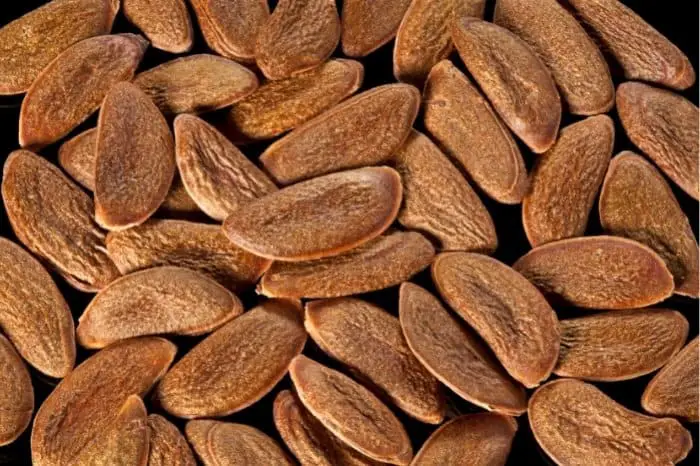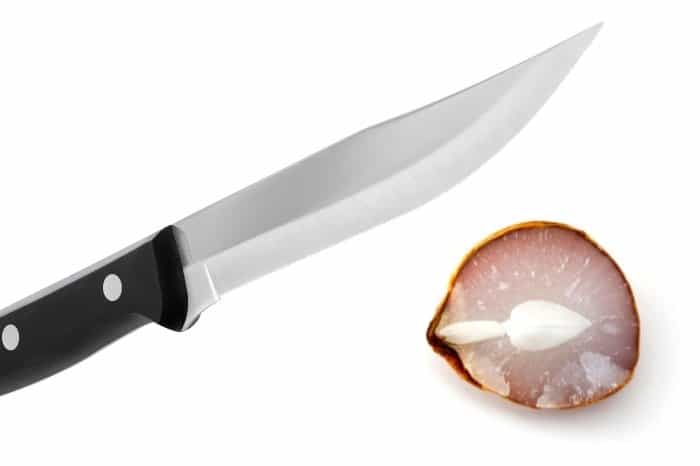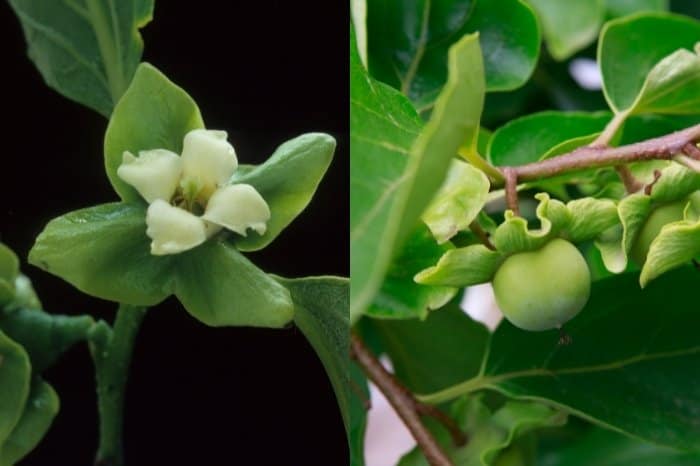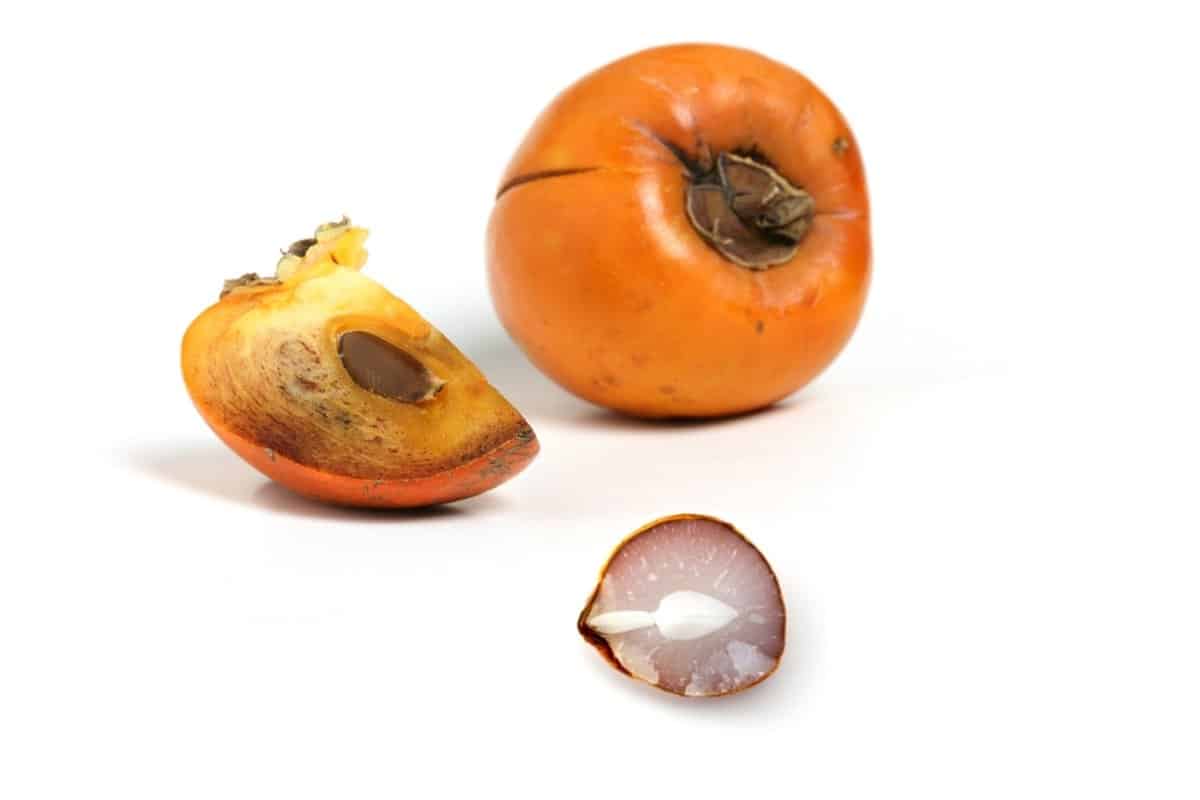Last Updated on December 17, 2022 by Griselda M.
You have probably heard that you can predict the winter weather using a seed, but do you know how to open a persimmon seed?
According to traditional weather folklore, it is believed you can predict the weather when you open a persimmon seed. If you can crack open a persimmon seed from ripe fruit, it is believed to forecast the winter weather.
The cracked-open seed displays three different shapes that are interpreted in different ways.
- Fork shape – winter will be mild.
- Knife shape – The winter will be bitingly cold that cut like a knife
- Spoon shape – there will be a lot of snow
But, have you already checked the upcoming weather for this year?
What Is A Persimmon Seed?
Persimmons are small orange fruits about the size of a peach or plum, depending on the type of persimmon you grow.
American Persimmon trees (Diospyros Virginiana) grow both cultivated and wild. You can find it growing wild in USDA zones 4 to 9. Japanese persimmon trees (Diospyros kaki) do well in the warmer part of the range of zones 7 to 9. The Japanese persimmon trees produce larger fruits than the American ones and are prized for their bounty harvest.

Persimmon fruits are less known than other fruits like apples, loquats, plums, etc. However, you can buy them from the grocery store and farmers’ markets across America during the autumn season.
They have an astringent taste, but this goes away as the fruits soften. They are packed with Vitamin A, healthy to eat, and delicious to enjoy.
Most Japanese persimmon varieties are seedless, so you will have to use the American persimmon to forecast the weather. If this tree does not grow in the neighborhood, try to get some American persimmon from the farmer’s market. These are more likely to have local persimmon in stock, and you can ask for the origin from the seller.
Read more about What Temperature is too Cold for Plants
How To Cut A Persimmon Seed?
Opening a persimmon seed needs technique because the task is not easy. The outside of this seed hull is super tough. But if you wait for the seed to dry, it becomes easy to split open dried seeds. But if you are excited about it and can’t wait for the seed to dry, go ahead and open the seed you have.
To split the seed open, you can use a knife. Hold the seed parallel to the flattened side and cut it open. Be careful when using a sharp knife, as many people have cut themselves in the process of opening up this seed.

How To Predict The Weather With An Open Persimmon Seed?
Get a locally grown persimmon seed. A locally grown persimmon is important because it will reflect local conditions. Wait for the fruit to get mushy before you can cut the seed open.
Cut open the fruit to release the seed. Open the persimmon seed and look at the shape displayed inside.
The shape of the kernel inside could be fork-shaped to mean there will be mild winter with high powdery snow, or spoon-shaped, meaning plenty of snow is on the way, or knife-shaped, meaning frigid winds will be blowing cutting like a blade.
Grow Persimmon From Seed
Persimmon trees grow all year round with their showy foliage and golden-orange autumn fruit. The fruits add brilliant color to the late-season landscaping tree.
The persimmon tree has over 40 species, but only a few are regularly grown, including the (Diospyros virginiana) and the Japanese persimmon (Diospyros kaki). These two varieties grow reliably well from seed, although seed propagation is not easy, especially if you try to reproduce a specific variety.
The common American persimmons are much harder than the Japanese, with the Japanese thriving in zones 7 to 9A and the Americans doing well in zones 4B to 9B.
Gathering Persimmon Seeds For Planting
Persimmon seeds germinate best when they are fresh – so gather them in autumn right after the fruit softens. Take the seed only from the fully ripe persimmons with no bird pecks, green skin, or rotten skin.
Cut open the fruit and take out a few seeds. Soak them in warm water for a few days to loosen the sticky flesh. Rub the persimmon seeds lightly under running water to clean them. Go ahead and start the seeds immediately or store them in a cool, dry place until you are ready to use them.
How To Treat Your Seed
The persimmon seeds need to be treated before planting. They need a period of moist chilling to help them germinate. The chilling or cold stratification process is similar to the natural process of overwintering the seeds outdoors.
To treat your seeds, wrap them in a moistened paper towel or sphagnum moss and put them in a plastic bag or jar inside the fridge for about 2 to 3 months. If the paper towel or moss dries out, spritz it with some water to keep the seeds moist.
Jobe’s Organics 09224 Fruit & Citrus Fertilizer
How To Germinate Your Seeds
Persimmon seeds should be planted in well-drained soils. Sow one seed per pot in sterile pot mix, making sure the pot has good drainage holes.
Plant the seeds at a depth of 2 inches and set the pots in a warm and bright location. Should the temperatures stay below 70 degrees F, try warming the pots with a propagation-heating mat. The seedlings should appear in 6 to 8 weeks.
Taking Care Of Your Seedlings
It is easy to take care of your seedlings. They will need bright, indirect, and evenly moist conditions to grow healthy and strong.
Keep your seedlings outside under sheltered are during the spring months before exposing them slowly to the sunlight in 1 or 2 weeks.
Water your seedlings weekly but allow the soil to dry out between watering to keep the roots healthy.

Planting Your Seedlings
Persimmon seedlings need to be planted at the end of their first full growing season, best done in autumn after the first rain.
Choose a planting site that is at least 20 square feet of space tolerant of most soil types, but they thrive in most soil types.
This tree takes about 3 to 5 years to bear fruits to need some patience. To keep the soil around the tree always moist in a favorable way, spread a thick mulch around the base. The mulch also helps in picking the fruit that has fallen.
Why Do Some Persimmons Not Have Seeds?
Ever wondered why do some persimmons not have seeds? The reason why some American persimmon varieties produce seedless fruit is that the tree is self-fertile. This means that, unlike other trees that need a male pollinator to cultivate fruit, varieties like the Prok’ persimmons don’t. These are cold hardy trees that grow well in the north of the persimmon region and gardeners can look forward to huge seedless fruit from this species.
Additionally, Asian persimmons are mostly self-pollinating. These plants are known to produce parthenocarpic fruit even if their blooms are not fertilized. However, keep in mind that although these plants produce fruit, they are unable to reproduce as they are seedless.
So, permissions that are seedless are trees that have not been pollinated. If you prefer these fruit with seeds, then growing a few varieties of cultivars is recommended as it will aid in the pollination process to produce seeded fruit.
How Big Are Persimmon Seeds?
If you are wondering how big are persimmon seeds then we have the answer for you. Seeing that the fruit reaches a size of 1 to 2 inches in diameter when fully mature, the seeds inside it can vary very slightly in size. Each fruit has about a minimum of 5 seeds.
These seeds usually grow to a size of about 3/4 inches in length and 1/2 inch in width. However, keep in mind that the size of the seed will also heavily depend on the cultivar you’re growing. This is because there are significant differences in fruit and seed size between American persimmons and other varieties grown around the world.
While some seeds produce larger fruit, others may not. If you consider the single-stemmed or multi-trunk deciduous trees like the D.Kaki, the seed size is somewhat different in size to others in this species. Keep in mind that these varieties are often referred to as ornamental plants that are inclined to tropical environments.
How Long Are Persimmon Seeds Viable?
How long are persimmon seeds viable will depend on a lot of factors? These include how you store and maintain them which ultimately preserves them for future use. In general, persimmon seeds can be stored for two to three months in a vacuum-sealed bag in the refrigerator.
This is because these plant seeds would need to be stratified in a cool and moist environment before planting them. Keep in mind that this is an important step to make the seeds viable as eliminating this process will result in dormant seeds that would not be able to germinate.
If your look at the process of persimmon trees growing in their natural habitat in the wild, they undergo a stratification process that does not require any interference because it occurs as it was supposed to. The fruit naturally falls off the tree, rots, or gets consumed by animals, and the seeds sit naked on the ground with a blanket of leaves and brush during the winter season.
During this time, the process of stratification happens which ready the fallen seeds for growth in the fall season. That’s about a three-month process on its own which means that persimmon seeds are viable for that length of time. Germination is achieved much easier when seeds are properly treated and viable.
Persimmon Tree Seed Conclusion
That’s all there is to it! Go ahead, cut a persimmon seed, and tell us what you see in there and your location.
FAQs
How do you crack open a persimmon seed?
I tried putting it in a pair of scissors and cutting it, but the seeds weren't coming out. Then I tried putting it in a pencil sharpener, but nothing happened. Then someone told me to put it on a hot stove for 15 minutes. This worked like a charm, and now I'm ready to make Persimmon Cake with Walnut Streusel.
Do you cut open a persimmon seed?
It’s been a while since I was around the seed-cutting table, but my best recollection is that you can either just slice a persimmon seed in half, or you can slice it lengthwise and then use a knife to cut the seed down the middle. I’ve also seen people use a spoon to cut open the seed, but that sounds like a pain.
Are persimmon seeds safe to eat?
Yes, they are perfectly safe to eat. They contain no toxic substances. They are low in fat and high in fiber. They are a good source of vitamin C, vitamin A and calcium.
Are you supposed to eat the skin of a persimmon?
The skin is edible, and the flesh is quite delicious as well. I have to admit that I had never heard this before. But I was told by someone that eating the skin is traditional for the Japanese and Korean people.
How do I eat a persimmon seed?
Persimmons are the fruit of the tree Diospyros kaki, which has a yellow/orange seed that looks like a persimmon. It can be eaten raw or cooked, and it is edible.
Should I use a knife to cut one open?
It's not really a good idea to cut persimmons without a very sharp knife and a steady hand. I've had a few bad cuts over the years, but if you're going to try it, be sure to use a very sharp knife.
When do they ripen?
Persimmons are grown all over the world. The two main varieties of American persimmons are the Hachiya and Fuyu. Both varieties ripen in late fall.
Can a persimmon seed predict the winter?
You’ve probably heard of the “wisdom of the ancients,” which says that a persimmon seed can predict the coming winter.
It is true and false. It is true in that the fruit of a persimmon tree is very sensitive to temperature. It ripens in early fall, when the weather turns cold.
Caroline is a gardener who loves to get down to the nitty–gritty of gardening. She proudly proclaims herself as a ‘dirt worshipper‘ and can often be found deep in the garden, covered in soil and singing to her plants. As a self–proclaimed ‘plant whisperer‘, Caroline believes that plants need love and attention just like any other living thing, and she loves to give them both. When she‘s not tending to her garden, you can often find her researching the latest gardening trends, or teaching others how to make their gardens thrive



